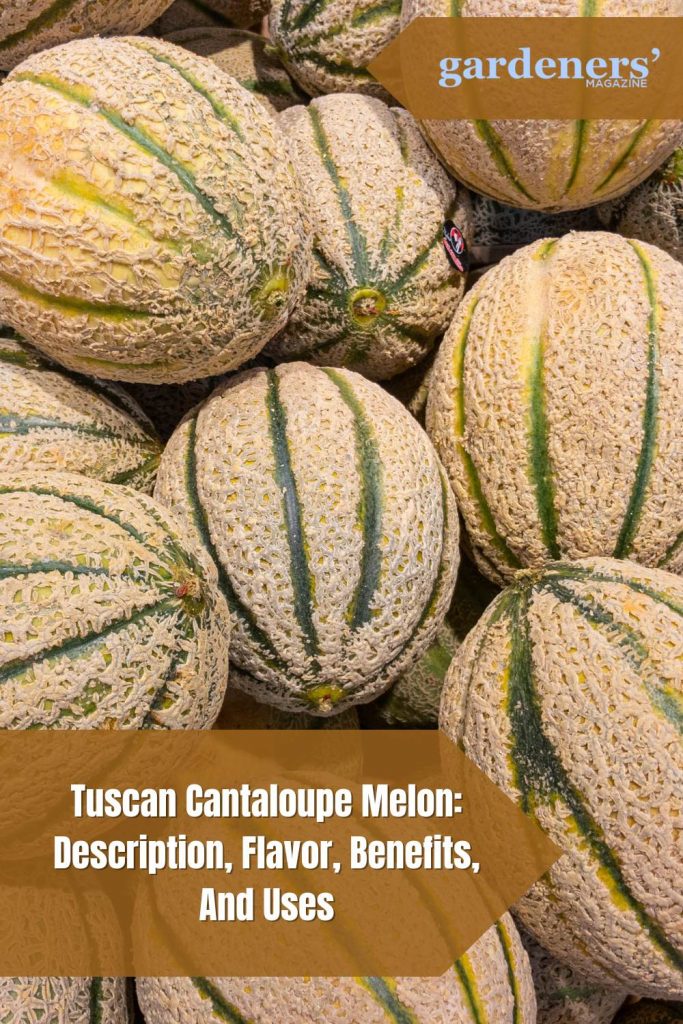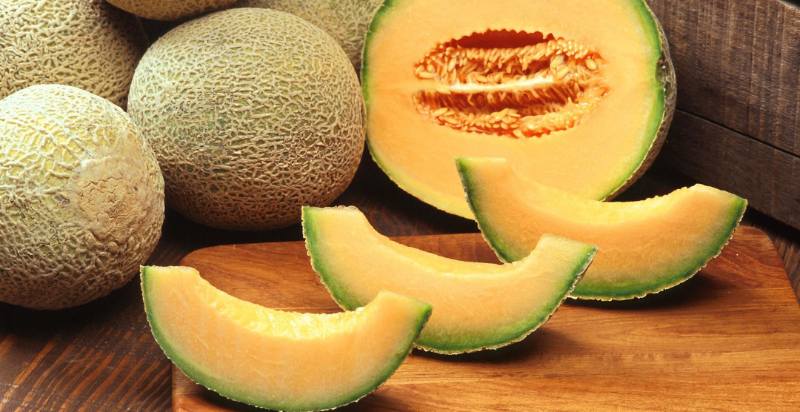Tuscan Cantaloupe Melon, also known as “Cantalupo di Monte San Savino,” is a variety of melon native to the Tuscan region in Italy. This melon has a sweet and juicy taste, with an intense aroma reminiscent of honey and apricot. The fruit has light green skin, yellowish flesh, and a black seed cavity in the center. It is known for its high sugar content, which makes it one of the sweetest varieties of melons. Here is everything you need to know about Tuscan Cantaloupe Melon.
What is Tuscan Cantaloupe Melon?
Tuscan Cantaloupe Melon is a variety of melons native to the Tuscany region of Italy. It has sweet, juicy flesh and a unique flavor that differentiates it from other melons. The outer rind ranges in color from yellow-green to orange-yellow with white netted veins. Tuscan Cantaloupe Melons are typically larger than most other varieties and can weigh up to 5 pounds.
Not only are they delicious when eaten fresh, but the flesh of this melon is also great for making jams, salads, and cocktails. Tuscan Cantaloupe Melons are an excellent source of Vitamin A and Vitamin C, potassium, and fiber. So if you’re looking for a delicious and nutrient-rich treat, Tuscan Cantaloupe Melon is the perfect choice.

History and Origin of Tuscan Cantaloupe Melon:
The Tuscan Cantaloupe Melon is believed to have originated in the Tuscany region of Italy. Farmers in the region first cultivated the melons during the 15th century, quickly gaining popularity throughout Europe due to their sweet taste and pleasant aroma. During this time, they were mainly used as a dessert fruit but soon became popular in various salads and savory dishes.
The melons were eventually brought to the United States by Italian immigrants who settled in the Eastern United States during the early 20th century. Today, Tuscan Cantaloupe Melon is grown throughout the country and enjoyed by professional chefs and home cooks.
Description of the Tuscan Cantaloupe Melon:
Tuscan Cantaloupe Melon is a large, round melon with smooth skin and juicy orange flesh. It has an oval shape, measuring about 14-20 cm in diameter and 8-10 cm in height. The rind ranges from green to light yellow with dark green netting on the surface. The seeds are small and black. Tuscan Cantaloupe Melon has an excellent flavor that can be enjoyed fresh or cooked in salads, desserts, smoothies, or jams. It also makes a great addition to fruit bowls or platters.
Cultivation of the Tuscan Cantaloupe Melon:
Tuscan cantaloupe melons are generally grown in well-drained, nutrient-rich soil with a pH between 6.0 and 7.5. The plants should be spaced at least 6 to 8 feet apart and planted in holes filled with aged compost or manure. They prefer full sun but can also tolerate partial shade during the hottest hours. Mulching around the plants helps retain soil moisture and control weeds.
Watering is important for the best growth and yields, especially during pollination and fruit development. Tuscan cantaloupe melons require about an inch of water per week, preferably early morning, so that excess moisture can evaporate quickly. If it is very hot and humid, you may need to water more often.
Fertilization is necessary to ensure healthy growth and abundant harvests. A balanced fertilizer (10-10-10 or 12-12-12) can be applied once a month during the growing season, but it is important to follow the directions on the package for exact amounts and timing. Compost tea or fish emulsion may also be used as additional supplements.

Harvesting of the Tuscan Cantaloupe Melon:
Harvesting the Tuscan Cantaloupe Melon is an important stage in melon production. This type of melon is harvested at the peak of its sweetness when it has a light orange to golden color on the outside. Farmers must carefully inspect each plant and hand-pick the ripe melons from their vines to do this. Once picked, the melons should be placed in a shallow container or basket so they can easily be handled and transferred to where they are sold.
What are the Health Benefits of Tuscan Cantaloupe Melon:
Tuscan cantaloupe melon contains many vitamins and minerals, including Vitamins A, B6, C, E, folate, and niacin. It is also high in dietary fiber and antioxidants which help reduce inflammation. This antioxidant-rich fruit helps protect against cell damage from free radicals that can lead to diseases such as cancer, heart disease, and diabetes.
Tuscan cantaloupe melon is also an excellent source of potassium, which helps lower blood pressure and maintain normal fluid balance in the body. It contains a high level of magnesium, which aids in the relaxation of muscles and nerves, as well as calcium for healthy bones. Additionally, it has a good amount of iron to keep your energy levels up.
What does Tuscan Cantaloupe Melon Taste Like?
Tuscan Cantaloupe Melons have a distinct sweet-tart flavor. They are mild, juicy, and fleshy with a smooth texture. The aroma is slightly fruity, and the taste has hints of honey and citrus. When ripe, Tuscan Cantaloupe Melons are usually creamy yellow, although they may also appear more orange or green. The rind is slightly fuzzy, and the flesh is succulent and flavorful. Tuscan Cantaloupe Melons are best enjoyed chilled for optimal flavor. They can be used in salads, juices, smoothies, salsas, and other dishes.
Where Does Tuscan Cantaloupe Melon Grow?
Tuscan cantaloupe melon is native to the Mediterranean region, particularly in Italy. It is primarily grown in Lazio, Abruzzo, and Molise. It can also be found in Sicily and Calabria, as well as in certain parts of France and Spain. Tuscan Cantaloupe Melon is a variety of muskmelon, which is a type of melon that has a hard rind and netted skin. This variety is unique for its sweet flavor and aromatic aroma. It is generally harvested from June to September in Italy.
In recent years, the production of Tuscan Cantaloupe Melon has expanded to other parts of the world, like California in the United States or New Zealand. These melons have a much shorter shelf-life than those grown in Italy, so they are often purchased when ripe and eaten immediately. Tuscan Cantaloupe Melon can be found canned or frozen in grocery stores worldwide. Its popularity has made it an international favorite fruit.
Where can the Best Tuscan Cantaloupe Melon be Found in the Market?
The freshest and most flavorful Tuscan Cantaloupe Melon can be found in local farmer’s markets and specialty food stores. Some farmers may even sell the melons from their stands or make them available at roadside stands. These fresh, in-season melons will have a richer flavor than store-bought varieties, making them perfect for snacking or recipe used.
Other sources include online specialty food stores, which can offer various melon varieties worldwide. Lastly, some supermarkets may carry the Tuscan Cantaloupe Melon seasonally, usually in summer. It is best to check with your local store to see if they are available. With a little luck, you should find the perfect melon for your needs.
What are the things you need to keep in mind when Buying Tuscan Cantaloupe Melon?
- It is important to buy ripe but firm melons. Look for those that are heavy and have a slightly bumpy, waxy feel to the skin. The color of the rind should be a deep yellow, with some netting (a netted pattern) on its surface.
- Smell it before buying; ripe cantaloupe will smell sweet and fragrant.
- Avoid any melons that have blemishes, bruises, or decay.
- Buy organic and locally grown melons for the best flavor and nutritional value.
- Store cantaloupes in the refrigerator after they are cut open, as this can cause them to get mushy. Store at room temperature and use as soon as possible.
- Use a sharp knife to cut it open, making sure to discard the seeds along with any white sap that may be present. This sap is edible but very bitter in taste.
Cantaloupe can be enjoyed fresh or used in salads and soups. It also makes an excellent addition to smoothies and juices.
What is the Best Way to Store Tuscan Cantaloupe Melon?
The best way to store Tuscan Cantaloupe Melon is to keep it refrigerated. The melon should be kept in a perforated plastic bag or an airtight container in the fridge at a temperature of at least 40°F (4°C). If storing for up to two days, you can leave the melon on the counter at room temperature.
When ripe, the melon should be eaten as soon as possible. If you have any leftovers, store them in an airtight container and place them in the fridge for later consumption. The flesh of the Cantaloupe will start to deteriorate over time, so make sure to eat it quickly.
How to Use Tuscan Cantaloupe Melon in Recipes?
Tuscan Cantaloupe Melon makes a wonderful addition to summer salads. Slice thinly and add to your favorite greens. Or, make a refreshing fruit salad with chopped melon, strawberries, blueberries, and grapes.
Melons are also great grilled. Slice into thick wedges and sprinkle with olive oil and herbs such as rosemary, thyme, or oregano. Grill on each side until lightly charred, and serve warm.
You can also add Tuscan Cantaloupe Melon to smoothies for a sweet and refreshing flavor. Blend with Greek yogurt, ice, honey, and a scoop of your favorite protein powder to make a delicious power shake.
Tuscan Cantaloupe Melon also makes a great addition to salsas. Dice the melon and mix it with chopped tomatoes, onions, cilantro, jalapeno peppers, lime juice, and salt to taste. Serve on tacos or as a dip for fresh vegetables.
These are just a few creative ways to make Tuscan Cantaloupe Melon part of your recipes. So go ahead and get creative in the kitchen – your taste buds will thank you!
Conclusion:
Tuscan Cantaloupe Melon is an incredibly versatile summer fruit that can be used in various recipes. From salads to salsas to shakes, this delicious melon adds a sweet and refreshing flavor to any dish! Store it properly and eat it quickly once ripe for the best flavor. Enjoy exploring all the inventive ways you can use this delicious melon in your recipes.
Happy cooking!
- Everything You Wanted to Know About Red Tamarillos - June 2, 2025
- A Guide to Tulips: Everything You Need to Know & More… - June 2, 2025
- Guanabana: Description, Flavor, Benefits, And Uses - May 27, 2025

8 thoughts on “Tuscan Cantaloupe Melon: Description, Flavor, Benefits, And Uses”
Comments are closed.